Introduction: In this article, Melissa Davenport Berry continues her series on Mayflower descendants, focusing on the family of John Billington. Melissa is a genealogist who has a website, americana-archives.com, and a Facebook group, New England Family Genealogy and History.
Today I continue with my series on “Mayflower Descendants: Who’s Who,” again focusing on Elizabeth “Beth” Anne (Annis) Coughlin, a direct descendant of Mayflower passengers Elder William Brewster, the spiritual leader of Plymouth Colony, and the not-so-pious but very colorful John Billington.
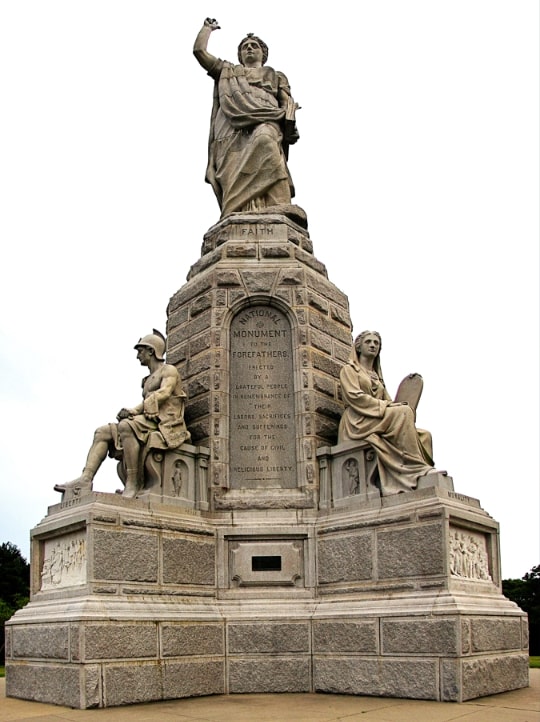
To recap: Recently I have been working with Elizabeth on her application for membership into the General Society of Mayflower Descendants. She descends from Elder Brewster through his daughter Patience, who married Governor Thomas Prence.
To view Elizabeth’s full lineage as well as intel on her connection to Mayflower passengers, see Part 1 and Part 2.

Below is a list of the Mayflower passengers and what category they fall under (“Saints” or “Strangers”).
According to the San Antonio News:
Only 41 of the 102 [Mayflower] colonists came to the New World for religious reasons. They were called “Separatists,” or more properly, Brownists, followers of Robert “Trouble Church” Browne [aka “The Father of the Pilgrims”], a famous dissenter from the Church of England. They referred to themselves as “Saints” [William Brewster was one].
The other Mayflower passengers were either servants or tradespeople hired by the Mayflower’s investors, the Merchant Adventurers, sponsors of the voyage to establish the colony. The religious contingent called the tradespeople “Strangers” (this group included John Billington). The “Strangers” were mostly members of the Church of England who came from London and Southwest England.
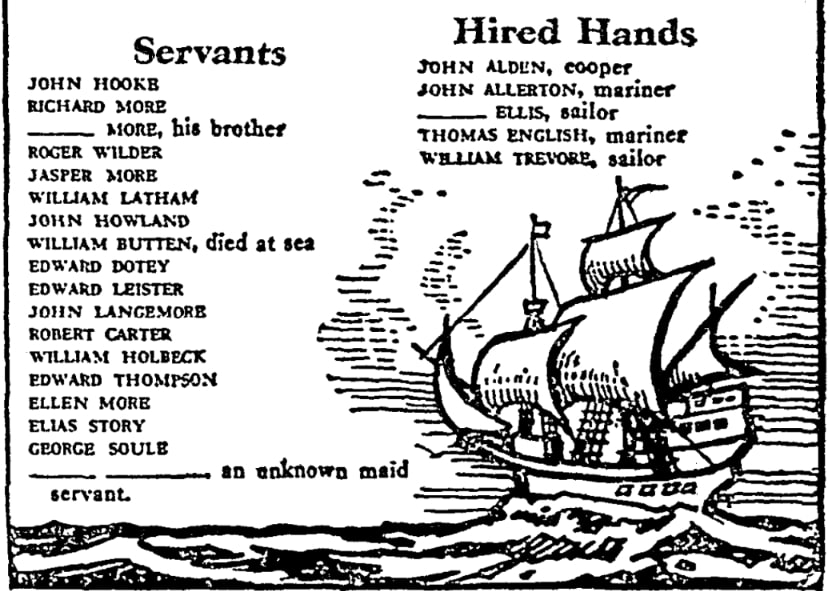
Accompanying the passenger list was this article.
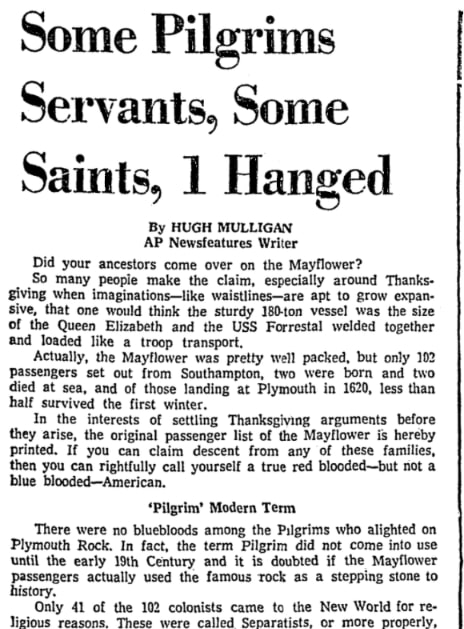
This article notes that John Billington was hanged in 1630 for killing John Newcomen (or Newcomin) “with a blunderbuss.” It also quotes William Bradford, who referred to the Billington clan as “one of ye profanest families amongst them.”
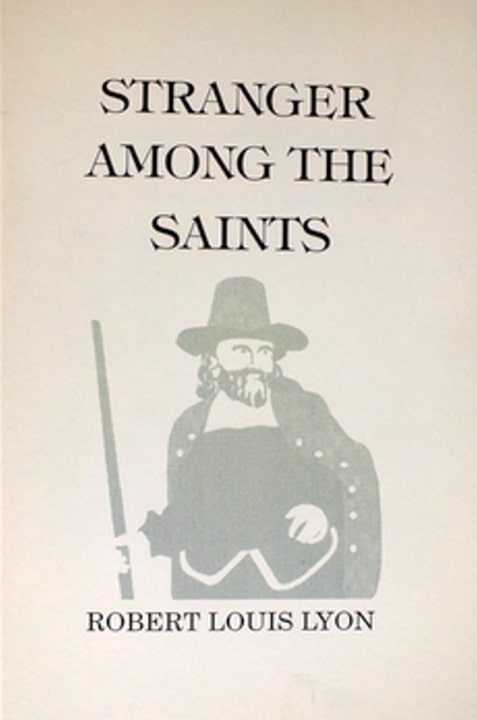
According to Nathaniel Philbrick in Mayflower: A Story of Courage, Community and War, Bradford had consulted with Massachusetts Bay Governor John Winthrop on the matter, and after discussing it with him determined that Billington “ought to die, and the land to be purged from blood.” (p. 175)
My last story left off with John Billington’s predicament which is told by Flying Santa and historian Edward Rowe Snow in his newspaper column “Sea and Shore Gleanings” published in the Patriot Ledger. Snow believes Billington got a raw deal. He offers up a defense for Billington.
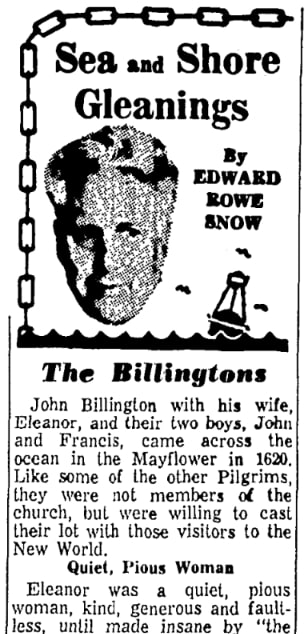
Snow writes:
The whole story of John Billington’s accusation, trial, and execution is clouded in mystery and contradiction. Bradford gave it 11 lines in his journal which he wrote 20 years after the occurrence.
Mourt’s Relation mentions it even more briefly. William Hubbard likewise copied Bradford in general but differed in saying that the occurrence was accidental rather than deliberate.
There was no mention of the incident in Morton’s New England Memorial which was written with special reference to the first colony of Plymouth. It is possible Morton did not approve of Governor Bradford’s action in ordering Billington hanged.
The details are as follows:
Billington had been a hunter and trapper for 10 years in the colony when the town was visited by an individual named [John] Newcomin. Billington suspected his traps had been robbed, and caught Newcomin in the act. He gave chase when the man fled, and fired a round of buckshot when the man hid behind a tree, hoping to frighten him off.
Unfortunately Newcomin chose that moment to peer out, and was struck in the shoulder. Billington took the injured man to the village immediately and summoned a doctor. Newcomin was a careless sort who did not follow orders. The wound became inflamed, gangrene set in, and he died.
Governor Bradford at once accused John Billington of murder, but his friends rallied round and contended that it was an accidental killing. Billington, heartbroken, considered himself the cause of the man’s death, but his friends contended that if murder had been intended he would have fired while the robber was running, and as he was a sure shot, they questioned why he waited until the man hid behind a tree.
Below is a passage from Bradford’s journal about Billington’s case.
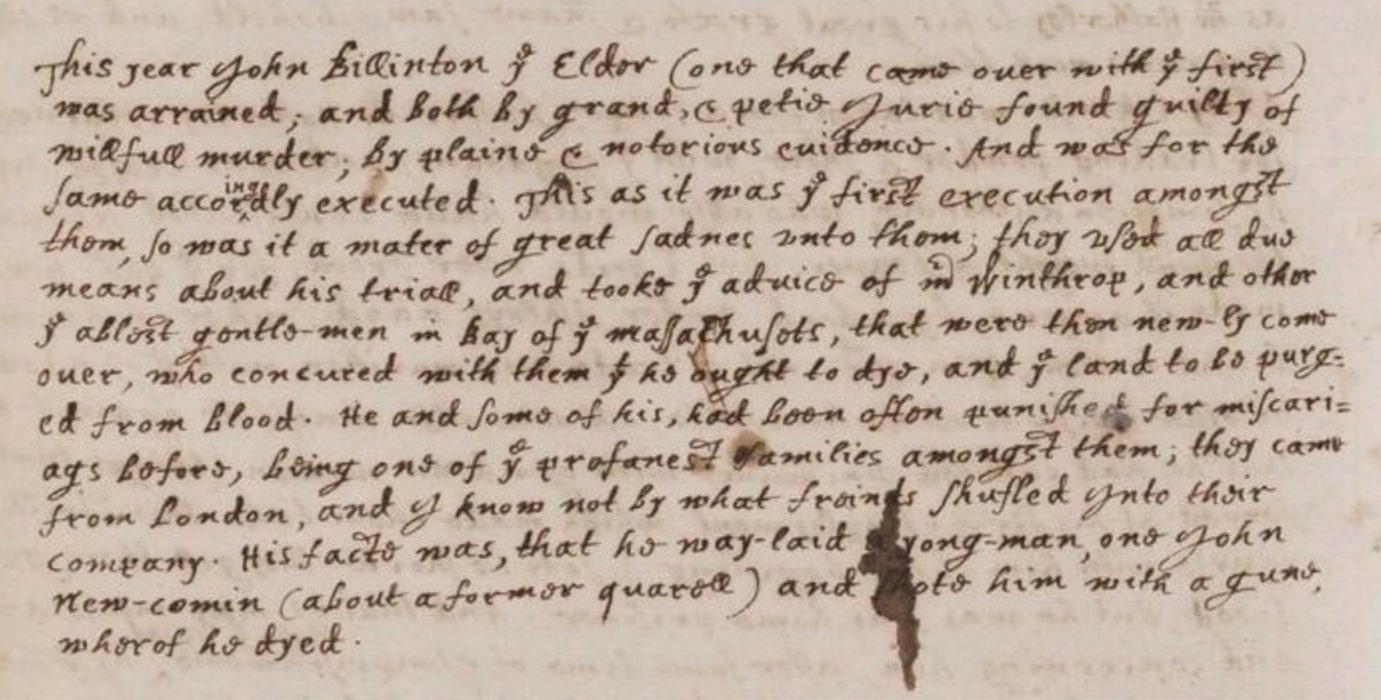
More from Snow’s column:
Supreme Law
The governor’s will apparently was the supreme law of the colony at the time, as there were no laws or criminal code at Plymouth until 1636. Bradford states that John Billington had a regular trial by jury, but this apparently is to be questioned. Billington was hanged.
Below is a photo of John Billington Sr. and his two sons, John Billington Jr. and Francis, portrayed by reenactors at Plimoth Plantation.

Snow further notes:
Francis Billington was the sole survivor of the Billington family, He was one of the original purchasers and settlers of Middleboro, a man of property and influence. He married a widow, Christiana Penn Eaton, a lady noted for her Christian virtues and “sweet loveliness.”
They had nine children, all of whom grew up to be honorable, industrious members of society.
Elizabeth “Beth” Anne (Annis) Coughlin descends from Francis’s daughter Mary, who married Samuel Sabin.
More intel on the Billington family:
While John Sr. was the first to be executed in Plymouth Colony, his widow Eleanor/Helen, one of only four women to survive to the first Thanksgiving, was among the first to have a prenuptial agreement when she married George Armstrong. A copy of the contract made between the marital parties can be found in Ancient Landmarks of Plymouth on page 348.
Besides his most notorious stunt – almost blowing up the Mayflower before it even landed – Francis Billington was nabbed for drinking and tobacco on the highway in 1639. A full history of Francis can be read at Pilgrim Hall Museum.
Additional read: John Billington, the Plymouth Martyr by George Prince.
To be continued…
Explore over 330 years of newspapers and historical records in GenealogyBank. Discover your family story! Start a 7-Day Free Trial
Note on the header image: “Mayflower in Plymouth Harbor,” by William Halsall, 1882. Credit: Wikimedia Commons.
Related Articles:

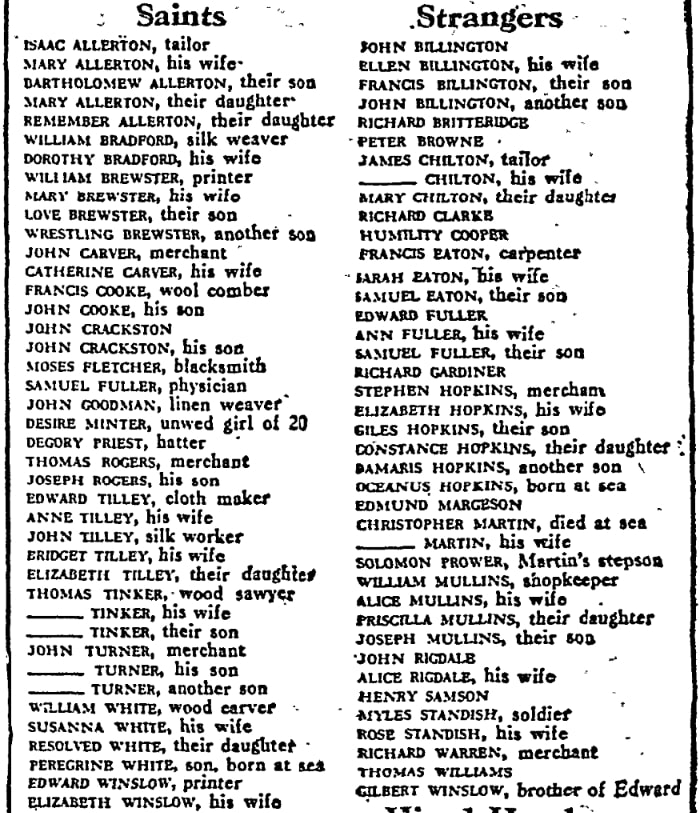
I am a descendant of Degory Priest. Thanks for writing this.
Hi Connie, I am glad this story reached and you enjoyed it. I love to hear from descendants.